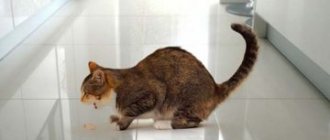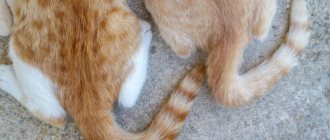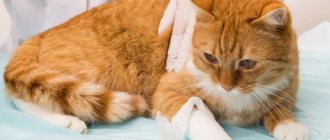Any decrease in the ability of one or more of a cat's limbs to bear weight, or a change in the normal mobility of a limb, can be called lameness. The lameness can be extremely mild or severe and affect one or more limbs. It can be intermittent or constant, worsening in the morning, at night, after rest, after or during physical activity.
There is no breed or age predisposition to lameness. Lameness may be associated with injury or develop gradually, as with a bone tumor. The underlying cause of lameness may be life-threatening, or may merely reduce quality of life, as with debilitation and painful arthritis.
Causes
Sudden lameness is most often associated with injury. Injuries can be very different: a splinter in the paw, an insect bite, an unsuccessful jump that caused damage to the wrist ligaments (especially in overweight cats). It may also be associated with spinal diseases. Intervertebral disc extrusion in the neck can cause severe lameness in one of the forelimbs.
Sometimes cats begin limping unexpectedly when the underlying problem has actually already been present for some time, such as with neoplasms.
Infectious causes of lameness in cats
Lameness on the front paw is a characteristic symptom of calicivirus, a viral disease that affects unvaccinated cats. Pets 2-24 months of age can get sick.
Be sure to read:
Otitis in cats: symptoms and treatment, description, treatment with medications and folk remedies
Additional symptoms:
- refusal to eat;
- ulcers and stench from the mouth;
- cough;
- runny nose;
- conjunctivitis.
Lameness occurs suddenly and disappears spontaneously. Another cause of infectious origin is fungal diseases that affect the claws. The horny formations become fragile, break, and it hurts the cat to walk.
Diagnostics
Anamnesis collection involves a detailed description of the onset, duration and changes in the manifestations of lameness, treatment, if any. The doctor should evaluate how the cat stands, sits, and walks. Sometimes, especially if the lameness occurs periodically, or the cat is very nervous at the appointment, it can be useful to videotape its movements at home and show it to the doctor.
A general examination will also include a careful orthopedic examination - careful examination and palpation of all extremities, identification of pathologically altered or painful lesions, and determination of joint mobility.
Neurological examination. Not all lameness is due to orthopedic problems. A neurological examination may be recommended if the problem is suspected to be at the level of the brain or spinal cord, nerves or muscles.
Other diagnostic tests may be performed, most often x-rays, joint puncture and examination of joint fluid may also be used; ultrasound; CT; MRI; myelography; biopsy; X-ray with contrast.
The cat is limping on its front leg: what to do, treatment
If the pet rests on its paw, it does not have a fracture. When an animal is given an injection in the front paw, the lameness is explained by a painful reaction to the medication.
If after 24 hours the swelling has not subsided and the injury site is hot, a visit to the veterinarian is necessary. If you suspect a fracture, your pet should be taken to the clinic immediately and given first aid.
First aid for a cat
In the first minutes after a bruise, cold is applied to reduce blood flow and minimize the volume of hematomas. If 15-20 minutes have passed, the procedure is useless.
If a fracture is suspected, especially when the integrity of the skin is broken, the damaged area is cleaned of dirt with a soft cloth. Do not wash the wound with water. The site of injury is treated with Chlorhexidine or Miramistin, the limb is immobilized and taken to the clinic.
Be sure to read:
The cat is limping on its hind leg without visible damage and shaking its paw or pulling it back
Drug therapy
If the injury occurs as a result of a cut, puncture, or a splinter has stuck into the paw, the foreign body is removed and the injured area is treated with an antiseptic. In such a situation, the limb heals in 2-3 days, and the lameness will disappear.
With the development of joint inflammation, pain can occur not only in the front paw. The veterinarian prescribes anti-inflammatory drugs and feed additives containing chondroprotectors.
Elderly animals, depending on their condition, are transferred to therapeutic food for cats suffering from musculoskeletal pathologies.
If the claw is damaged and test results show infection with fungi, external antifungal agents are prescribed. If the fall on the paw is caused by calcivirus, the veterinarian will use medications to treat the underlying disease. When the cause of lameness cannot be determined, antispasmodics or analgesics are used.
Surgical intervention
The clinic examines the damaged paw; if necessary, the veterinarian prescribes laboratory and instrumental tests.
If the claw is damaged, it is trimmed. In case of complex fractures or multiple fragmentation of bones, osteosynthesis surgery or amputation is suggested.
Treatment
Treatment can be as simple as limited mobility for a few days for a minor tendon or ligament sprain, or as complex as orthopedic or neurological surgery.
Sometimes the exact cause of lameness may not be identified. In such cases, a period of limited mobility, possibly with anti-inflammatory treatment, may be recommended to see if the lameness responds to this conservative approach.
Surgery will almost always require postoperative hospitalization and the use of pain medications for a smooth and comfortable recovery. The length of hospital stay and the need for intensive care depend on the severity of the cat's condition, the severity of the problem, and the extent of surgery.
Gravity classification of lameness
- Mild or temporary lameness : The cat has a limp, but the symptom disappears, so the lameness is not a major problem.
- Persistent lameness with support : The cat still places its paw on the ground, but the lameness remains constant. This is a more serious stage, especially if the symptom lasts several days (about 1 week).
- Constant lameness without support : The cat has stopped pressing its paw at all, this indicates that the pain is severe, which means it is very serious, you should definitely contact a veterinarian.
Home care
After surgery, you will need to maintain rest and restrictions for your pet. This can last for at least six weeks (for example, with fractures), and the restriction of mobility will cause protest in the cat. However, exercising too early or too heavily will lead to re-injury and make the problem worse. To limit mobility, a cage, playpen or separate room is used in which the cat does not have the opportunity to jump or climb.
If your cat has an external suture, it should be inspected daily for swelling, redness, or discharge. Stitches or staples should be removed 10 to 14 days after surgery.
Some cats simply cannot tolerate the dressing, despite no complications at the surgical site. Elizabethan collars can be helpful in most cases, but the bandage should be removed if it becomes more of a problem than a help.
A cat is limping on its front leg: how to recognize a fracture or bruise
If the cat is limping, the owner needs to make a preliminary diagnosis in order to develop an algorithm for his subsequent actions.
When a fracture occurs, the following signs are observed:
- the paw swells along the entire length, and not just at the site of injury;
- upon palpation, displacement of the bone or joints is felt;
- the integrity of the skin may be compromised;
- the cat is in severe pain and meows all the time;
- the cat does not try to lean on the broken paw;
- the injured limb looks unnatural.
The bruise is characterized by the following symptoms:
- a hematoma appears at the site of the injury;
- the cat is leaning on a limb, but is limping;
- no displacement of bones or joints;
- skin integrity is preserved;
- the injury site is hot;
- the pet constantly licks the swelling;
- touching the paw causes aggression.
However, the final diagnosis is made by a veterinarian based on the results of an examination and x-ray.
Elbow dysplasia
This disease is not considered the most typical for cats, but... Yes, in the case of outbred “Murks” everything is exactly like that.
They practically do not suffer from this pathology; cases are extremely rare. It’s just that in recent years things have been much sadder with purebred cats. The problem is selection. More precisely, in poorly carried out selection: many animals end up in breeding that should not have been allowed there, as a result of which the breed acquires many “bad” genes. The characteristics of the pathology are as follows: As is easy to understand, the forelimbs are affected (as a rule, the pathology is well manifested only on one paw).
The disease is hereditary. If you do not know the breeder, and there are no people among your acquaintances who bought kittens from him, it is better not to take risks. Animals must be purchased only from trusted persons who will not allow sick pets into breeding.
Elbow dysplasia is diagnosed at the age of two or three years, or even earlier.
The severity of symptoms varies greatly from cat to cat. Your pet may be lucky, and then he will only be bothered by intermittent claudication, or he may be unlucky, and then without surgery he will not be able to fully move.
Therapy (full) is exclusively surgical. Anti-inflammatory drugs, painkillers, etc. are prescribed only in mild cases when the body’s compensatory reserves have not yet been exhausted. When the cat is already noticeably falling on the sore paw, drug treatment will not give much effect.
Injuries and lameness
The obvious cause of lameness is injury to a pet's paw. A cat can protect a limb for the following reasons:
- Splinter in the paw pad.
- Injury.
- Sprain.
- Damage to claws.
It is important to try to recall in memory all the events preceding the onset of lameness. If the cat fought with other animals or fell from a great height, the paw hurts due to a bruise or sprain.
A splinter caught in the foot pad can cause severe discomfort. In this case, the cat cannot remove a small foreign body on its own. Since acute pain is felt when putting pressure on the damaged paw, the animal begins to protect it, which is why lameness appears.
The cat does not step on its front paw due to damaged claws. This can also happen if you fall from a great height or get hit. In addition, if someone accidentally steps on a cat's paw, the claw may be broken, which causes the animal a lot of discomfort.
What should the owner do?
Helping a kitten with a broken front paw.
If you notice that your pet is limping, the first thing to do is to immediately examine the paw . Perhaps the cause will become clear, for example, damage or a foreign body in the limb itself.
If there are no visible injuries, you need to take your cat to the vet. He will conduct a manual examination and, most likely, the pet will have to undergo x-rays. Only after a thorough diagnosis will it become clear why the lameness occurred and how serious the situation is, will a treatment strategy for the cat be proposed.
First aid
The cat has a swollen paw and is limping: what to do?
First of all, if a bruise is detected, the animal should be calmed. Then apply ice or a cold object to the sore spot. If the pet has a fracture, then the paw must be fixed and sent to an animal clinic. Here the doctor will take an x-ray and decide on further treatment.
Cat with broken paws
Important! You should not give your cat medications from your home medicine cabinet. They help humans, but can cause serious harm to animals.
Joint diseases
Lameness can be caused by a congenital abnormality of the structure of the joints - dysplasia. In this case, the animal will have difficulty stepping on the affected limb from childhood. Other joint pathologies include arthritis and degenerative changes in the joints of the front paws. As a rule, such diseases are rare and mainly occur in older cats with metabolic disorders, acromegaly or obesity.
Symptoms indicating problems with the front paw of a pet:
- Change in gait.
- Refusal to jump on chairs and other surfaces.
- Lethargy.
- Frequent licking of the sore limb.
When the owner tries to touch the sore paw, the cat reacts sharply, pulling it away, running away or hissing. If this condition persists for more than a few days, you should contact your veterinarian as soon as possible. To make a diagnosis, the doctor will palpate and examine the affected limb. Radiography is mandatory.
Lameness due to infection
If the cat begins to limp on its front leg, it may have become infected with calcivirus. This disease of an infectious nature is very easily transmitted from a sick animal to a healthy one. For prevention, many cat owners vaccinate them against this disease. Animals that have not been vaccinated can become ill with calcivirus very easily.
In addition to lameness, signs of this disease may include:
- breathing problems;
- conjunctivitis;
- nasal discharge;
- damage to the paw joints;
- the presence of ulcers on the mucous membranes.
This disease causes inflammation of the anterior joint chambers. This is why the cat is limping on his front leg. What should owners do in this case? If you have calcivirosis, the animal should, of course, be shown to a specialist. Treatment in this case is complex - therapeutic and symptomatic.
Another infection that can cause lameness in a cat is a fungus. In this case, dermatophytes often affect not only the animal’s pads or its skin, but also its claws or joints. Lameness in cats in this case develops due to inflammation.
Symptoms of pathology
Most often, limb paralysis does not occur immediately. First, signs of motor dysfunction appear, which is why the pet does not immediately lose control of its legs, but gradually. Veterinarians recommend not to hesitate to contact the clinic
if the following symptoms appear:
- The cat begins to hesitantly step on the pads. Before he steps, he tries to find his balance.
- Dragging appears when the cat is unable to move its paws: it drags them without lifting them off the floor. It seems that the pet is sneaking up on the prey during the hunt. The next stage will be paralysis of the lower or lateral part of the body.
- The cat's limbs move greatly when walking or standing.
- Constant back squatting. This often occurs in older individuals over 10 years of age.
- Severe swelling in the pelvic cavity due to bites from dogs or other cats, trauma, problems with internal organs or the lower part of the spine.
- General loss of mobility even in a young animal. The cat prefers the opportunity to lie down and relax to games.
The appearance of one or more symptoms becomes a reason to contact a veterinary hospital. Delay in consultation may result in paralysis of part of the body.
The only non-dangerous situation is a wobbling gait in small kittens. This is a natural reason, it is explained by the weakness of muscle tissue at a young age. This goes away over time and does not require therapy.
In what cases should a cat be taken to the veterinarian?
When is specialist help needed? When the animal exhibits at least one of the following symptoms:
- the cat cannot walk at all or moves with great difficulty;
- when you touch the paw, the pet meows and abruptly pulls it away;
- the cat does not step on its paw, tucking it in when moving.
It is also worth visiting a specialist if the cat’s lameness is accompanied by loss of appetite, high fever, increased fatigue, lethargy or aggression. These are already very alarming symptoms.










